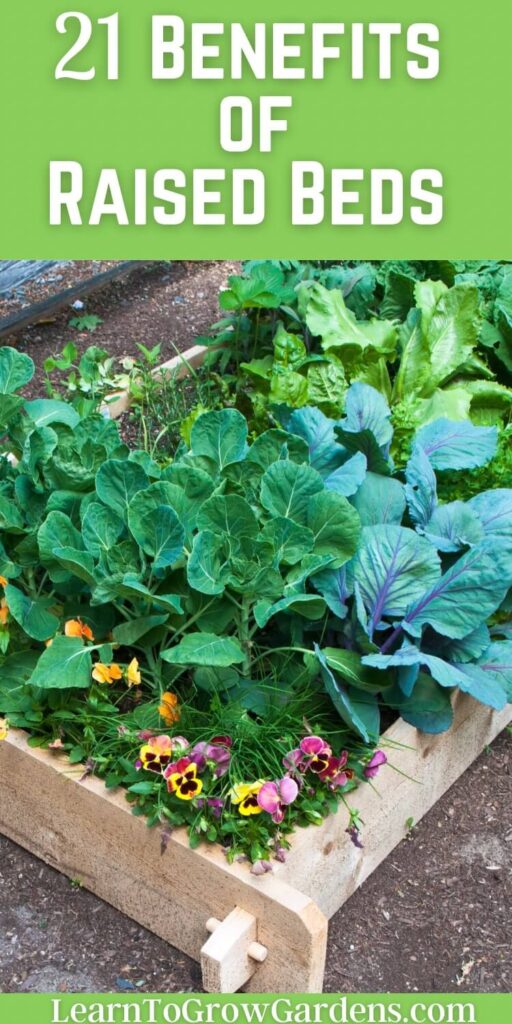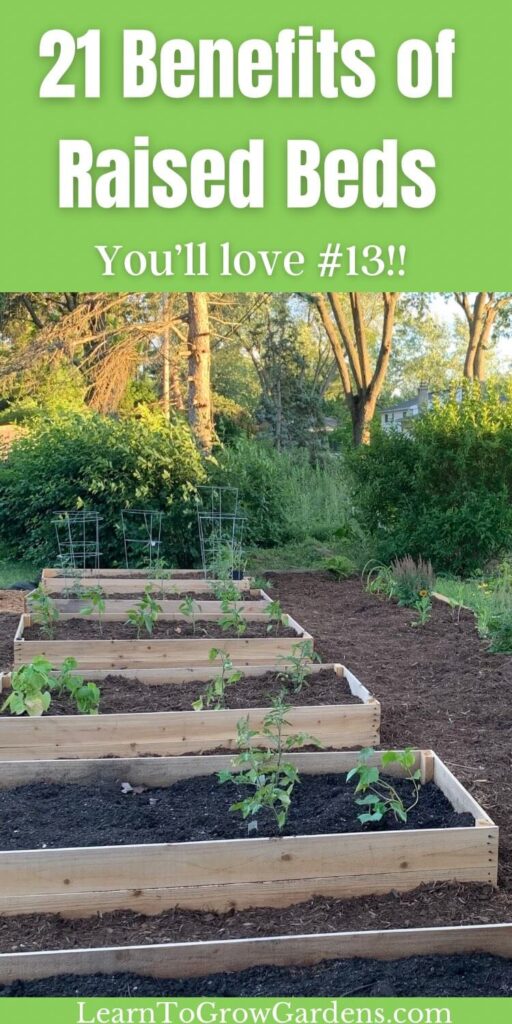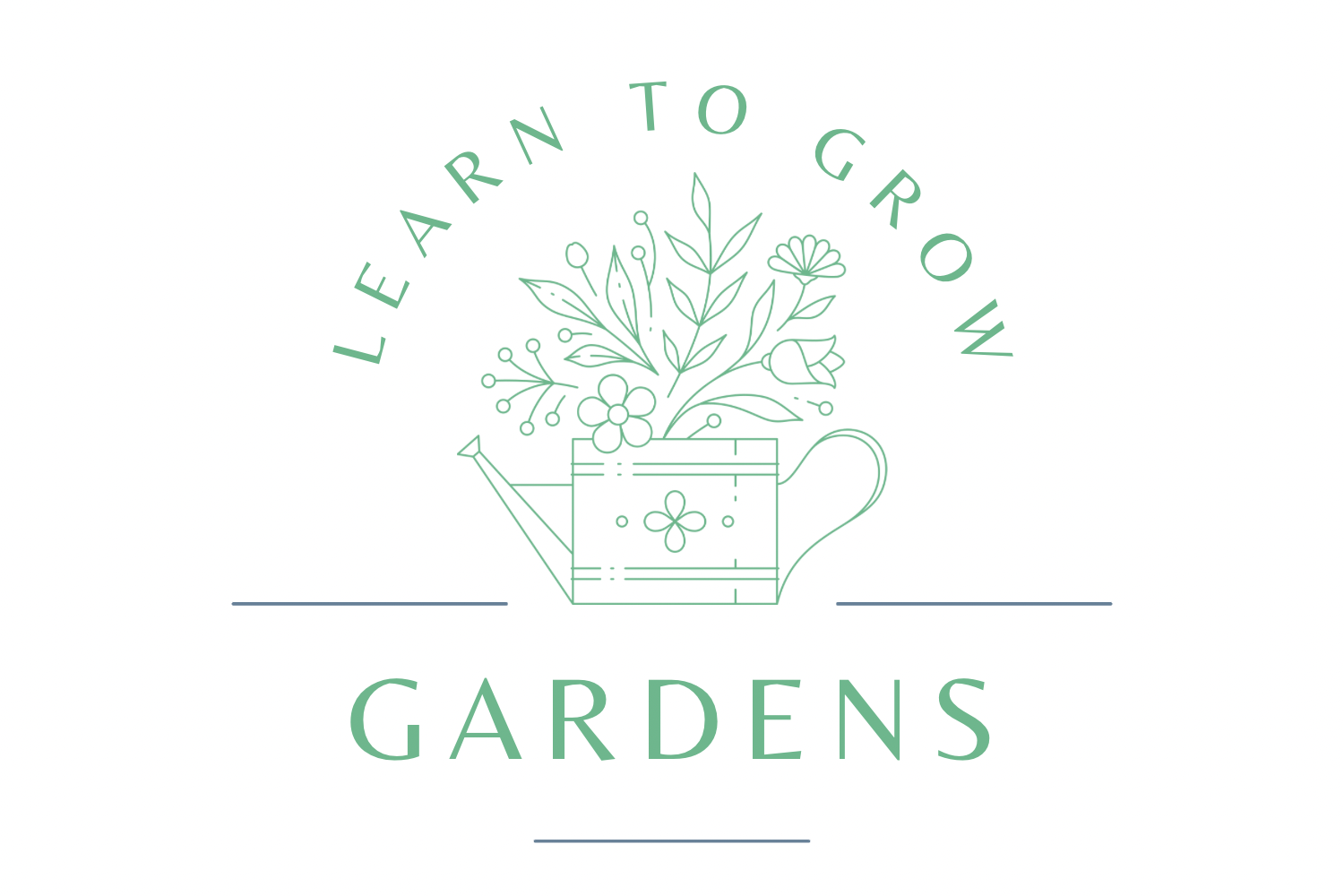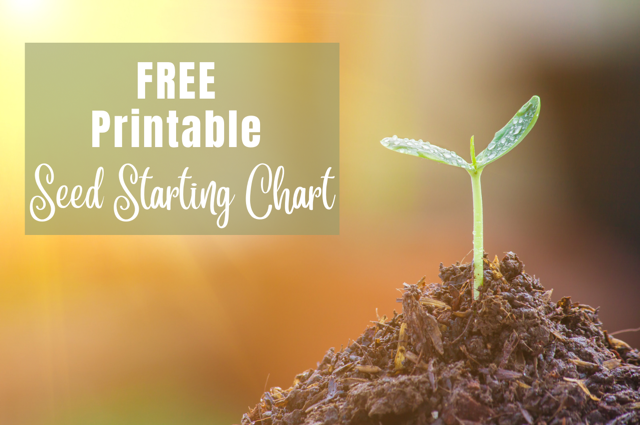
21 Benefits of Raised Garden Beds
Raised garden beds are growing in popularity, and for good reason! They not only look good, but they also have several advantages over traditional in-ground garden set ups.
When I first began growing a vegetable garden, I started everything in the ground. My crops did okay, but they weren’t great.
One year, I even rented a few thousand square feet at a nearby farm. I hoped to grow almost everything we ate that summer, but it was a very wet summer with heavy rains. I could hardly walk through the fields, and I lost more vegetables than I gained.
At home, I continued to grow a few vegetables in my raised bed garden in my backyard. I was blown away! With much, much less effort from me, my crops did wonderfully. I had less pest and disease pressure, and my vegetables were much larger than anything I had grown in the in-ground beds.
Raised beds have many advantages over growing directly in the ground. They are popping up in backyards everywhere. I’ve even noticed a trend with homesteaders who have acres of land to garden in. They’re creating beautiful, functional raised garden bed spaces instead of the traditional rows of vegetables seen on farms.
Read on for 21 benefits of raised garden beds and decide if this method of growing is right for you!
Benefits of raised bed gardens:
1. Easier on your back and knees. Let’s admit it, bending down to the ground to do all your gardening tasks can be tough on your back and knees. The more time you spend in the garden, and the more years that go by, the more this is true. Raised beds have the advantage of an adjustable height, meaning less bending over and squatting. Raised beds can be built as high as needed, but even a modest height of 12” makes harvesting and weeding easier on your body. They’re also a great option for gardeners with limited mobility. The bed and soil surface can be raised from ground level, bringing it to a height that is allows easier and more comfortable access.
2. Start with great soil from day one. Raised beds immediately give you nutrient dense, fluffy soil, regardless of the native soil conditions in your yard. It can take years to amend soil that is too high in clay, or sand, or lacking in nutrients. With raised beds, you create the perfect soil mixture, fill your beds up, and get to planting right away. Continue to add organic matter every year, and your raised bed soil will always be a great mixture for growing plants.
3. Raised beds are great for beginners. Since raised beds allow you to start with nutrient dense, fluffy soil, your fruits and vegetables are off to a great start from the very beginning. Along with less pressure from weeds, and the ability to drain excess moisture, and many other benefits mentioned in this post, beginner gardeners are set up for success from the start.
4. More prolific, larger harvests. Again, because of the ability to start with great soil, harvests from raised beds tend to be larger. The addition of organic matter each season keeps the soil happy and healthy and continues to provide those great harvests year after year.
5. Better drainage. Good drainage is what personally sold me on raised beds forever and ever. A couple summers ago, I very excitedly rented some growing space at a nearby farm and planted to my heart’s content. I dreamed of huge harvests at the end of the season. Then the rains came. And came. And continued to come. And the soil in the field I rented was very high in clay, as is a lot of soil in my area. The clay soil field was a swampy mess, with poor drainage, and what didn’t rot from the excess water was buried in weeds that I couldn’t get to, because the ground was too wet for walking. Everything I had grown at home that same summer, in my raised beds, did as well as it usually did. Even though my raised beds are only 12” high, they allowed all that rain to drain away, protecting my vegetables and plant roots. I could also keep them weeded, since I keep a thick path of mulch in between the beds that allows for drainage outside the beds, as well.

6. Raised garden beds retain moisture better than in ground gardens. Not only do raised beds allow for better drainage, but they also retain moisture in the soil better, as well. Seems counterintuitive, but the reason goes back to that perfect, fluffy soil. Good soil, with the right ratio of sand, silt, and clay, is able to retain the moisture it needs while draining away the excess. Native soil is usually too high in one part, or too low in another, which affects its ability to hold moisture. When you start with a good, nutrient dense, loamy soil, it’s able to hold just enough moisture to keep your plants happy and healthy.
7. Raised bed soil warms up quicker in the spring. When the sun begins heating the ground up in the Spring, raised beds have the advantage of having both the top *and the sides* exposed. This allows the soil temperature to rise much faster, since a greater surface area is being reached by the warmth of sun’s rays. The advantage of warming up quicker in the spring can allow you to begin planting vegetable starts and seeds a couple weeks earlier than you would be able to in the ground.
8. Raised beds allow you to plant earlier in the spring. As I just mentioned, the ability to warm up quicker in the Spring allows you to plant earlier, too. The warm soil drains quicker and is able to be worked much earlier than soil that’s in the ground.
9. Raised bed soil stays warmer longer in the fall. This is partly true, so I’ll explain the advantage I’m referring to. Raised beds have the disadvantage of being colder than the ground during the colder months, because the temperature surrounding them is colder. However, when the sun is out during the day, the soil in the raised bed warms up more than the soil in the ground. With proper planning, and selection of cold hardy vegetables, this can extend your season by another couple of weeks, as well. With an added cold frame or row covers, you can extend it even longer.
10. Plants in raised beds overwinter better. Although raised beds grow colder quicker in the winter, the better soil allows for healthier, stronger plants. This gives vegetables grown in raised beds an advantage over vegetables grown in the ground and can be just enough of an advantage to help them tough out the cold and frost. Many gardeners, me included, have been surprised to find a vegetable or two still going strong when spring arrives.
11. Raised beds keep children and pets from trampling the garden. Raised beds have the benefit of being raised from the ground, protecting plants from the trampling of little feet. They offer a clear boundary between pathway and garden, making it much easier to protect your garden from foot traffic.
12. Raised beds are more attractive. Raised beds have come a long way in becoming an aesthetically pleasing extension of your home. They can be made from corrugated metal, cement, or metal feeding troughs. Pretty arches and obelisks have replaced tomato cages and twine. With so many new options available, raised beds can be a beautiful part of your yard.
13. Raised beds don’t require the removal of grass to get started. When we installed our raised beds a few years ago, we had a lot of grass where we were placing 10+ beds. I couldn’t fathom digging up all that grass, and thankfully I didn’t have to. To install our beds, we mowed the grass as short as we could and laid cardboard on top. I made sure the cardboard was completely covering the grass, and then we laid each raised bed frame on top. We added our raised bed soil mix on the cardboard, up to the top of each bed. Our raised beds are 1 foot high, which is the minimum height I would recommend for this method. We also laid cardboard around the outside of each bed and put down 6 inches of mulch for paths. 3 years later, there are zero signs of grass the beds, and only weeds that have blown in over time. This is, by far, one of my favorite raised garden bed advantages.

14. Raised beds have less soil compaction. Soil compaction is when the soil becomes pressed together, instead of being light and fluffy. This makes it harder for water to flow through the soil and drain properly. When beds are in the ground, they can be stepped on by people, pets, and wild animals, which can compact the soil. Soil in the ground can also be heavier and denser, and more likely to become compacted. Raised beds have lighter, fluffier soil which allows roots to easily spread and grow, and water to flow evenly through it.
15. Raised beds allow you more control over what’s in your soil. Most of us are unaware of how our backyard soil was treated before it became ours. It can be full of pesticides and heavy metals, or full of too much clay or sand. When you add raised beds for growing, you have far more control over what is in your soil. You can even start with organic soil ingredients for an organic garden.
16. Raised beds reduce soil erosion. If you live in an area with heavy rain or steep slopes, soil erosion can be a constant problem. Raised beds help reduce soil erosion. They do this by containing the soil and preventing it from washing away. They also improve drainage, so soil is less likely to wash away. Raised beds can also be built into slopes and hills, allowing you to slow down the flow of water and prevent erosion.
17. Raised beds can start with a neutral soil pH. Different vegetables and fruits like soil at different pH levels. When you start with raised beds, you can start with a neutral soil pH by using a soil mix with a neutral pH. This allows you to then tailor the soil to the preferred pH for what you will be growing. You can do this by an amending the soil. Find out more here.
18. Raised beds can be better for root crops, like carrots and potatoes. Root crops need light, fluffy soil for best results. Since we’re growing them for the part of the plant that is under the soil, we want them to grow the best they can under the soil. When the soil is light and fluffy, and drains well, root crops can stretch and grow freely, leading to larger harvests. When root crops are grown in the ground, the soil is often too compacted or heavy. This can cause problems with drainage, or the plant’s ability to stretch and grow. Raised beds help eliminate this problem.
19. Raised beds can keep critters out of the garden. I appreciate this benefit to raised beds personally. In my neighborhood, we have herds of deer, a flock of turkeys, gophers, and chipmunks. It is a struggle to grow any vegetables without fighting the animals. With my raised beds, I have far more control in keeping them out of the garden. I keep hoops over my garden with landscape fabric or tulle, known as a row cover. This keeps out moths, beetles, and etcetera that try to attack my plants and lay eggs. I also keep plastic covers over my beds to keep out the larger critters. The wood base of the bed helps keep animals from burrowing under the covers. If you live in an area with animals that tunnel under the garden, such as gophers, you can attach hardware cloth to the bottom of your beds. The hardware cloth will act like a cage from the bottom, preventing animals from tunneling under and stealing your precious harvest.
20. Raised beds have fewer weeds. Since raised beds start with new soil, they allow you to start with a clean slate, free from weed seeds. This is a huge advantage over gardening directly in the ground, where you will be competing with years of weed growth. With regular upkeep and weeding, even weeds that eventually enter your raised beds can easily be kept under control.
21. Raised beds can be temporary. Sometimes we want to grow a garden, but we can’t dig up the current landscaping to put in a garden bed. An example of this would be a yard in a rental home, or a school garden. Raised beds, or garden boxes, can be placed over a patio or elevated on legs above existing grass. When it’s time for the garden to be removed, the raised garden bed can easily be moved to a new location without a large area needing to be fixed.
There you have it! 21 raised garden bed advantages. If you’re looking to start a garden, raised beds may be a good option for you! They’re a great way to get started with gardening, and despite the up-front cost, your success rate and greater harvests will make them well worth the investment!
You can purchase raised bed kits, build them yourself, or hire a gardening company to install them for you. No matter how you add a raised bed to your yard, they’re always a good idea!
If you’re looking for more information on growing a garden, be sure to check out these posts:

FAQ
Is raised bed soil better than garden soil?
Raised bed soil is often better than garden soil because it contains more organic matter and nutrients. It also drains better, and holds water more evenly, and has fewer weed seeds. All of these benefits add up to healthier plant growth.
What are the pros and cons of raised beds?
Pros of raised beds include healthy soil from the start, draining well, and being easier to reach while working in the garden. Cons include a higher up front cost, and more time and effort required when installing them.
Are raised beds better than pots?
Pots can be a great option for plants if you’re limited in space. However, raised beds have several advantages over pots. Raised beds don’t dry out as quickly as planters, they have more room, allowing you to grow more and utilize companion planting, and they’re sturdier than pots. They can also be covered with floating row covers to protect plants.
Are raised beds worth it?
Although raised beds have a higher up-front cost than growing directly in the ground, they offer many advantages that make them worth the time, effort and money to install them. Raised beds have healthier soil from the start, fewer weed seeds, and they drain better than growing in the ground. They also offer you a longer growing season and are easier to access than in-ground gardens.
Can you install a drip irrigation system in raised beds?
Raised beds are a great location for drip irrigation or soaker hoses. A water line can be run underground, and a drip line placed inside the bed. Watering your garden through drip irrigation is better for your plants, and will prevent excess moisture from overhead watering to wear down the untreated wood much faster.
Do raised garden beds work with square foot gardening?
Square foot gardening was designed to be done in raised garden beds. The rectangular shape of raised beds lends itself well to square foot gardening, and the added benefits of raised beds work well with the benefits of square foot gardening. For more information on this method visit this article from Better Homes & Gardens.

Hi, I’m Liz! I’m a Master Gardener, Garden Coach, and Professional gardener. I’m also a mom of 4 who likes to putz around in my garden, growing food and flowers. You can read more about me here.
I started Learn To Grow Gardens as a resource for anyone looking to find more success in the garden. You can find gardening help, inspiration, and community through my Facebook Group, Instagram page, and by joining my email list below.










I had thought about using my former herbal raised bed (moving the herbs elsewhere) for potatoes- you’ve just answered my question. Now I need to go study more about potatoes and try it!
Raised beds are great for potatoes! You can also try growing them in fabric bags. I have a blog post about growing potatoes in bags. I’ve had a ton of success with that method!